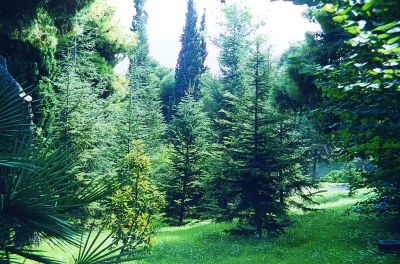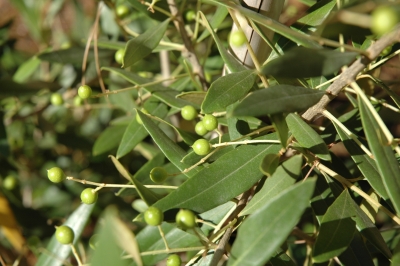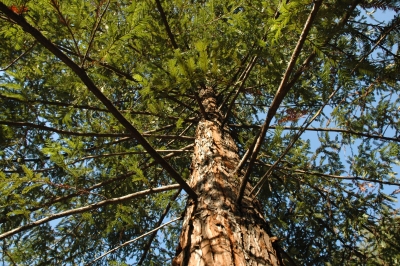
View of the Arboretum
A visitor entering the main gate of the Garden walks to the right through the Arboretum. Trees and shrubs from most continents grow in this large section divided into 6 subsections:
In the subsection of Oceania several species typical of the forestal flora of this particular continent can be seen. Species of Eucalyptus, Casuarina, Melaleuca, Callistemon, Acacia and Grevillea are planted in this section.
The subsection of Europe and the Mediterranean hosts the interesting taxa of Fraxinus, Quercus, Pinus, Cornus and Acer. Some well known species are also located in this section: Cedrus atlantica, Aesculus hippocastanum (wild chestnut) and Phoenix theophrasti, the famous through ancient times palm tree named after Theophrastus, the habitat of which includes only a few sites in Crete and south-west Turkey.

Olea chrysophylla
Gleditchia sinensis, a relatively small tree with enormous spines, Callicarpa arborea and Callicarpa japonica with their beautiful purple fruits, the early blooming Exochorda racemosa, the cedar tree of the Himalayas Cedrus deodara and the extremely rare Abeliophyllum distichum of Korean origin can be observed in the subsection of the non-Mediterranean Asia.
The African olive trees Olea africana and Olea chrysophylla and several species of Melianthus and Podocarpus will attract the attention of the visitor in the subsection of South Africa.

Sequoia sempervirens
The north-American gigantic evergreen tree Sequoia sempervirens reaching the height of 100 meters in natural conditions, various species of Dasylirion, Nolina and Agave, typical plants of Central America as well as the enormous Yucca baccata among many species of Yucca, are the impressive plants which one can observe while visiting the subsection of Northern and Central America.
Finally, in the subsection of South America, a visitor will observe among several plants, Bauhinia grandiflora with its large, white, aromatic flowers and several species of Schinus.